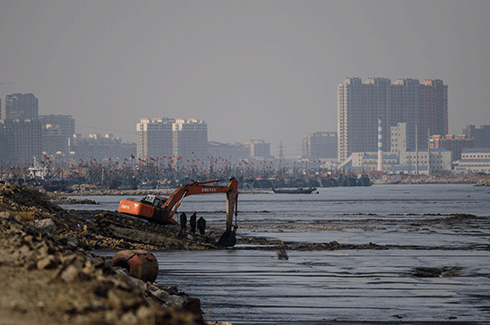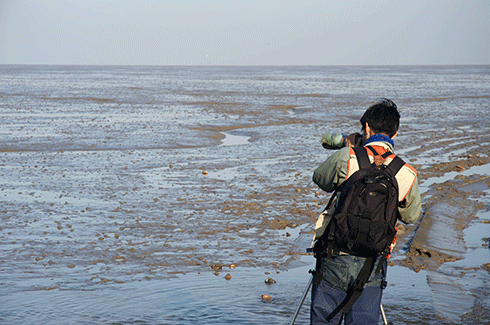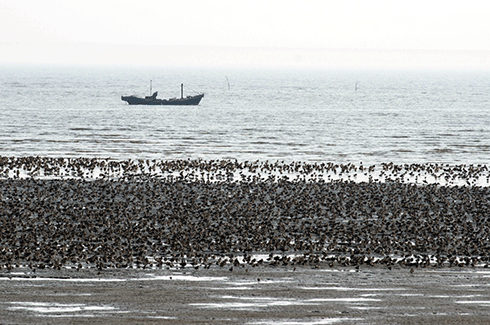Published: 19 January 2015
Mapping East Asia’s disappearing tidal flats
Nick Murray
Who speaks for the tidal flat? There are many voices for the mangrove forest, the coral reef and the seagrass meadow, but the chorus for the mud, sand and silt flats that sit hidden under shallow water for most of the tidal cycle is often silent.

|
|
In China alone more than 1.2 million hectares of wetland reclamation has taken place in the last 50 years, perhaps accounting for more than 5 per cent of the worlds’ tidal wetlands. Credit: Nick Murray
|
Not only do hundreds of species of migratory bird depend on them for their existence, this coastal ecosystem also protects large chunks of humanity and provides ecosystem services to hundreds of millions of people around the world.
A zone under pressure
The problem for all coastal ecosystems is the shifting character of the coastal zone. The last 50 years has seen the global human population migrating rapidly to coastal regions. As a result, coastlines around the world have become a focus of expansion of urban, agricultural and industrial areas.
This development is having a major impact on coastal ecosystems, which has resulted in the widespread loss and degradation of ecosystems such as mangroves, seagrasses, coral reefs and tidal flats. And that has major consequences for humans and nature.
In terms of the human cost, coastal ecosystems are a frontline defence that protects billions of dollars of infrastructure from storms and sea level rise, and maintaining their integrity is among the most cost-effective options for coastal protection.
Tidal flats are a widespread coastal ecosystem that is frequently overlooked in the planning and management of coastal resources. They are among the most widespread of any coastal ecosystem and, as well as providing ecosystem services to hundreds of millions of people worldwide, they sustain a suite of threatened and declining species.
For instance, tidal flats support the majority of the world’s migratory shorebird species, enabling their yearly migration from the arctic to areas as far south as Patagonia. Unfortunately, their proximity to centres of human population have also made these areas targets for cheap and rapid coastal development.
Drawing a mud map
So, what’s the magnitude of the problem?
Until now we have had no way of knowing just how much of this declining coastal ecosystem has been destroyed, or how much and where it remains. The principal reason for the lack of accurate maps of this ecosystem is due to the rapidly changing conditions they encounter: changing tides either expose or cover them, severely limiting the application of classical remote sensing methods.
To solve this problem, our small team of remote sensors and spatial ecologists have been developing methods to map tidal flats over very large areas.
Using the heavily developed tidal flats of mainland East Asia as a case study, we have developed a rapid mapping approach for identifying the distribution of tidal flats while assessing their changing status at continental scales.
The tidal flats in this region – which fringe the countries of North Korea, South Korea and China – are among the largest in the world, measuring up to 20 kilometres wide in some places. Our methods – utilising free data from the US Geological Survey’s Landsat archives and freely available regional tide models – allow fast implementation across thousands of kilometres.
Indeed, with more than 28,000 images to choose from, we determined the changing status of tidal flats across more than 14,000 kilometres of coastline.

|
|
Easily overlooked, and invisible for much of the tide cycle, mud flats are disappearing right before our very eyes. And their loss comes with an enormous cost. Credit: Nick Murray
|
Impacts of reclamation
Our results demonstrate that tidal flats in East Asia are being destroyed at rates similar to other major at-risk ecosystems, such as tropical forests and mangroves. The principal cause of these losses related to coastal development. Changes to sedimentation regimes due to the damming of major rivers is also an issue as this results in offshore losses of tidal flats.
In East Asia, land scarcity is a severe issue and often the cheapest method of acquiring land for large coastal developments is through land creation, often termed reclamation. Tidal flats, which are generally characterised by low-sloping flats in areas protected from severe weather, have proven an ideal environment for cheap and rapid coastal development.
This radical transformation involves the construction of seawalls, infilling and finishing for land use. These areas are then developed into new parcels of land for aquaculture, agriculture, suburbs and industry.
Loss of coastal wetlands to land reclamation is a global problem that is severely affecting the world’s coastlines. In China alone more than 1.2 million hectares of wetland reclamation took place in the last 50 years, perhaps accounting for more than 5 per cent of the world’s tidal wetlands according to some estimates.
This is clearly a symptom of China’s rapid coastal urbanisation. This arc of growth will form one of the world’s largest urban areas by 2030 – a continuous coastal urban corridor over 1800 kilometres long.
The rapid pace of coastal population growth and sea-level rise – as well as increasing demand for aquaculture, coastal wind farms, and tide energy – will certainly apply further pressure to the world’s tidal flats in the future.

|
|
The loss of tidal flats along migratory pathways, especially staging sites (where birds must replenish their energy stores during migration for long, energetically expensive flights) can have extreme consequences for shorebird populations. For the millions of shorebirds that migrate through the East Asian-Australasian Flyway, the intertidal areas of Asia are a crucial migratory bottleneck. Credit: Nick Murray
|
Uncertain future
An effective conservation strategy must manage the complex economic and social trade-offs that drive coastal development.
Decision-making that simultaneously plans for coastal development and coastal conservation along the world’s most rapidly developing shores is clearly needed.
For example, places where natural values have effectively been lost due to sediment depletion and coastal subsidence could be prioritised for development. As part of a carefully integrated plan, this could ease pressure on a functioning network of coastal protected areas and ensure continued delivery of ecosystem services.
Not only might this avert catastrophic extinctions of coastal biodiversity, it will also help us ensure we have a coastline capable of adapting to an increasingly uncertain future.
Dr Nick Murray is a Research Associate at the Centre for Ecosystem Science, University of New South Wales. He carried out this research in association with the Environmental Decisions Group (EDG), while completing his PhD at the University of Queensland. The EDG is a network of conservation researchers developing the science of effective decision making to better conserve biodiversity, and includes a number of Australian and International research centres, including CSIRO. This article first appeared in Decision Point – a free monthly online publication from the EDG.
More information
‘Tracking the rapid loss of tidal wetlands in the Yellow Sea’, published in Frontiers in Ecology and the Environment
‘Continental scale mapping of tidal flats across East Asia using the Landsat archive’, published in Remote Sensing
‘IUCN situation analysis on East and Southeast Asian intertidal habitats, with particular reference to the Yellow Sea (including the Bohai Sea)’, IUCN occasional paper







